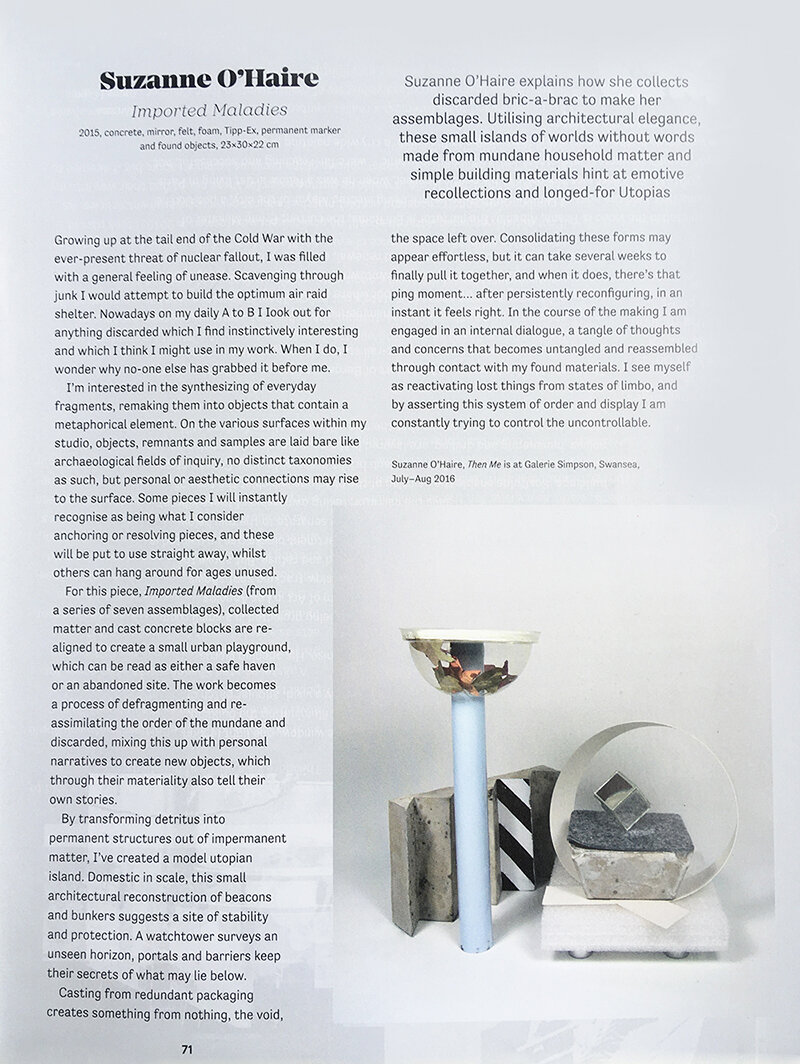Garageland 20: Remake Remodel looks at how times, events and materials are reassembled to create new times, events and materials – accentuating the new work that is born out of the old. Chic’s I Want Your Love becomes part of Moodymann’s I Can’t Kick This Feeling When It Hits. Chardin’s The Rayfish becomes Soutine’s The Rayfish with Twist of Bread. Shakespeare’s King Lear becomes Kurosawa’s Ran. Found film stills and footage become new and insightful in the hands of John Stezaker, Mark Rappaport and Douglas Gordon. Looking and revising existing material is unquestionably creatively stimulating.
Suzanne O’Haire
imported maladies 2015, concrete, mirror, felt, foam, Tipp-ex, permanent marker and found objects, 23 x 30 x 22 cm
Suzanne O'Haire explains how she collects discarded bric-a-brac to make her assemblages. Utilising architectural elegance, these small islands or worlds without words made from mundane household matter and simple building materials hint at emotive recollections and longed-for Utopias.
Growing up at the tail end of the Cold War with the ever-present threat of nuclear fallout, I was filled with a general feeling of unease. Scavenging through junk I would attempt to build the optimum air raid shelter. Nowadays on my daily A to B I look out for anything discarded which I find instinctively interesting and which I think I might use in my work. When I do, I wonder why no-one else has grabbed it before me.
I’m interested in the synthesizing of everyday fragments, remaking them into objects that contain a metaphorical element. On various surfaces within the studio, objects, remnants and samples are laid bare like archaeological fields of inquiry, no distinct taxonomies as such, but personal or aesthetic connections may rise to the surface. Some pieces I will instantly recognize as being what I consider anchoring or resolving pieces, and these will be put to use straight away, while others can hang around for ages unused.
For this piece, imported maladies (from a series of seven assemblages), collected matter and cast concrete blocks are realigned to create a small urban playground, which can be read as either a safe haven or an abandoned site. The work becomes a process of defragmenting and re-assimilating the order of the mundane and discarded, mixing this up with personal narratives to create new objects, which through their materiality also tell their own stories.
By transforming detritus into permanent structures out of impermanent matter, I’ve created a model utopian island. Domestic in scale, this small architectural reconstruction of beacons and bunkers suggests a site of stability and protection. A watchtower surveys an unseen horizon, portals and barriers keep their secrets of what may lie below.
Casting from redundant packaging creates something from nothing, the void, the space left over. Consolidating these forms may appear effortless, but it can take several weeks to finally pull it together, and when it does, there’s that ping moment… after persistently reconfiguring, in an instant it feels right. In the course of the making I am engaged in an internal dialogue, a tangle of thoughts and concerns that becomes untangled and reassembled through contact with my found materials. I see myself as reactivating lost things from states of limbo, and by asserting this system of order and display I am constantly trying to control the uncontrollable.

